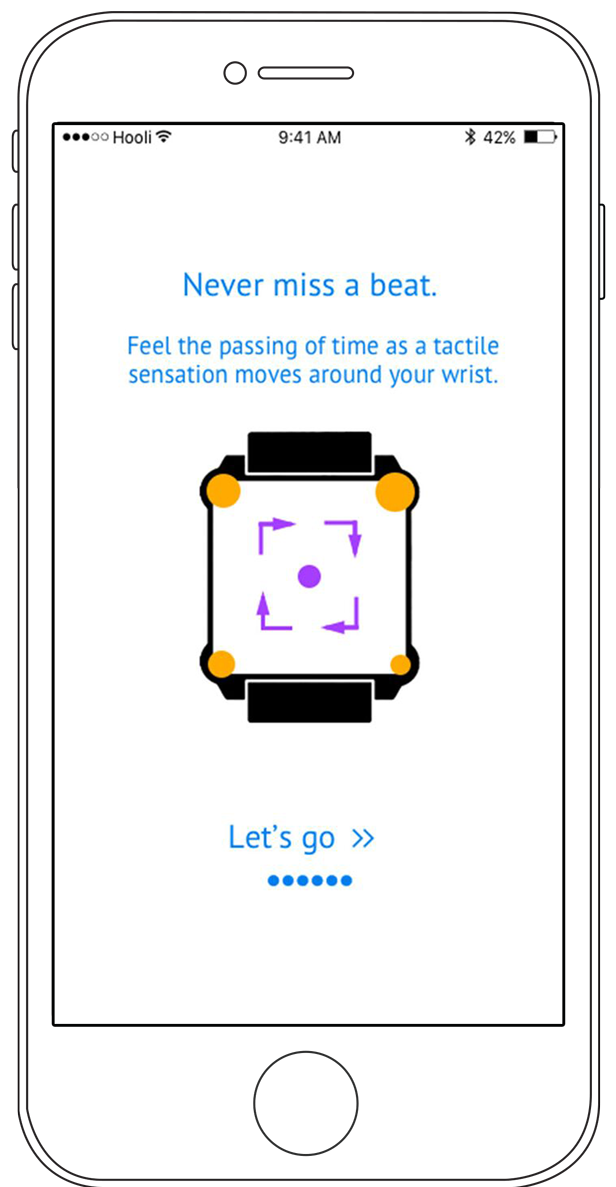This Wristband Can Trace Your GPS Directions on Your Skin
Our mobile devices communicate with us through sounds and screens, but a new wristband designed by Somatic Labs relies instead on touch.
Moment is a wearable device that vibrates to convey information. While phones and smart watches can send a generic alert by vibrating the entire device, Moment uses four motors to allow for different types of haptic feedback depending on what it is trying to say.
“You actually feel a shape being drawn on your skin as if someone was taking their finger and tracing out a triangle or an arrow in a certain direction,” cofounder and CEO Shantanu Bala says. “There’s a large variety of combinations of shapes we can make.”

Somatic Labs plans to ship Moment in early 2017 for $159 (or $129 if you order on Kickstarter); its functions will include GPS navigation, message notification, and a metronome feature. Instead of glancing at your phone’s screen every time a new GPS direction comes up, imagine having an arrow traced on your wrist. Moment starts out gently and then traces the arrow more intensely as you approach your exit.
For app, text, and other smartphone notifications, the device can assign different tactile patterns to different contacts so you know who a message is from. Developers will have the chance to develop applications that can be accessed from Moment’s phone app, the main interface through which users can set preferences and interact with the device. To repeat a notification, users can press a button on the side of the wristband or request it via gesture control.
Bala began developing haptic technology at Arizona State University’s Center for Cognitive Ubiquitous Computing. His work originally focused on adapting widely available technology so it could be used by people with disabilities. Moment grew out of Bala’s interest in helping people keep their eyes off a screen to remain engaged with their surroundings.

Katherine Kuchenbecker, director of the University of Pennsylvania’s GRASP robotics laboratory, says touch offers a powerful new way for electronic devices to communicate with humans.
“Touch cues can be private, salient, and quite expressive when designed well,” Kuchenbecker says. “The wrist is a particularly good location for delivering such cues because wrist wearables don’t interfere much with the use of your hands.”
Haptic feedback can also be essential in environments where hearing a notification is nearly impossible. Bala describes an industrial setting where a machine operator wears soundproof earmuffs and has limited visibility. A device like Moment could provide immediate feedback in the event of a problem.
The first version of Moment will have a battery that lasts from a few days to a week, depending on how intensely it’s used. Bala says the technology couldn’t be integrated into an existing smart watch or phone just yet because it would dramatically decrease battery life.
Somatic Labs isn’t trying to convert anyone away from the Apple watch, Bala says. But the company knows that some people have become disillusioned with smart watches. Instead of replicating the abilities of a smartphone in a smaller form, Moment is meant to augment them.
“If we’re creating wearables for the human body, we should do what the human body does best, which is feeling,” he says. “We definitely think it’s a product that has a wide appeal.”
Keep Reading
Most Popular
Large language models can do jaw-dropping things. But nobody knows exactly why.
And that's a problem. Figuring it out is one of the biggest scientific puzzles of our time and a crucial step towards controlling more powerful future models.
The problem with plug-in hybrids? Their drivers.
Plug-in hybrids are often sold as a transition to EVs, but new data from Europe shows we’re still underestimating the emissions they produce.
Google DeepMind’s new generative model makes Super Mario–like games from scratch
Genie learns how to control games by watching hours and hours of video. It could help train next-gen robots too.
How scientists traced a mysterious covid case back to six toilets
When wastewater surveillance turns into a hunt for a single infected individual, the ethics get tricky.
Stay connected
Get the latest updates from
MIT Technology Review
Discover special offers, top stories, upcoming events, and more.